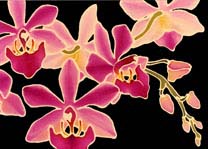Hybridizing with Phalaenopsis Species
by Bill Livingston
Phalaenopsis cochlearis
|
Perhaps the most predominant characteristic of this species is its shell-shaped lip. Because this lip seems to be passed on to its progeny, P. cochlearis has not been used much in hybridizing. When crossed with standard whites, almost all of its grexes produce white to pale yellow to yellow-green colors, and star-shaped flowers with a small spade-shaped darker yellow mottled lip. Some darker yellows were produced when crossed with some of the yellow species, such as P. fasciata, but no flowers with desirable shape resulted. Phalaenopsis cochlearis is not a fast or robust grower and is a little temperamental under greenhouse conditions; maybe this is another reason why the species has not been used in breeding. As I can remember, nothing really flashy ever showed up in its hybrids, but this does not mean that one of these days it will not produce something nice. Today there are many more yellow hybrids with which it could be bred to produce something usable in hybridizing.
|
|



This article which has been reprinted here with permission, originally appeared in the Volume 66, Number 4 edition of Orchid Digest, (Oct-Dec 2002), which is a Special Edition that highlights Phalaenopsis, and also features an excellent article on Phal culture by the Tuskes. The Phalaenopsis Special Edition of Orchid Digest can be ordered from Orchid Digest for $22. Highly recommended.
This article, all of its sections and accompanying photographs
are copyright 2002 by Orchid Digest Corporation.
Note: This site uses Javascript Navigation Controls;
if you have Javascript disabled on your Browser,
you will need to use the Site Map to navigate this site.
|

